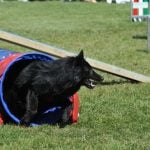Are you interested in learning how to train a dog to follow a scent? Understanding a dog’s scenting ability is the key to successful training. Dogs have an incredible sense of smell, and with the right techniques, they can be trained to follow a specific scent with precision. In this article, we will explore the process of training your dog to follow a scent, from selecting the right dog for scent training to troubleshooting common issues that may arise.
Dogs have an exceptional sense of smell, with some breeds being particularly well-suited for scent work. Understanding the capabilities of different breeds and selecting the right dog for scent training is essential for success. We will discuss the factors that make certain dogs better candidates for scent training and provide guidance on choosing the most suitable canine partner for this endeavor.
Additionally, we will delve into the necessary equipment and supplies needed to prepare for scent training. From harnesses and leashes to specific scents and treats, having the right tools at your disposal is crucial for effective training sessions. Whether you are new to dog training or looking to enhance your existing skills, this article will provide valuable insights into how to best equip yourself for success in scent training.
Selecting the Right Dog for Scent Training
When it comes to selecting the right dog for scent training, certain breeds are known for their exceptional sense of smell and natural inclination towards scent tracking. Here are some key factors to consider when choosing a dog for scent training:
- Breed: Certain breeds are better suited for scent work due to their strong sense of smell and natural hunting instincts. Breeds such as Bloodhounds, German Shepherds, Beagles, and Labradors are often top choices for scent training.
- Age: While dogs of any age can be trained in scent work, starting with a young puppy can establish good habits early on. Older dogs can also be successful in scent training with patience and consistency.
- Health: It’s important to ensure that the selected dog is in good health before beginning scent training, as this will ensure they can fully participate in the activities without any limitations.
Additionally, it’s essential to consider the individual personality and temperament of the dog when choosing a candidate for scent training. Dogs that are highly motivated by food or toys, have a strong desire to explore new scents, and exhibit focus and determination are often well-suited for this type of training.
Ultimately, the ideal candidate for scent training is a dog that displays a strong drive to use their sense of smell, has good physical health, and possesses the necessary temperament traits conducive to focused training sessions. With the right breed, age, health condition, and temperament considerations in mind, you can select a dog that is ready to embark on an exciting journey of scent training.
Preparing for Scent Training
Essential Equipment
Before embarking on scent training with your dog, it’s important to gather the necessary equipment and supplies. A quality harness or collar is essential for tethering your dog during scent training exercises. This will give you better control over your dog’s movements as they track scents. Additionally, a long lead is crucial for allowing your dog to explore and follow scents without getting too far away from you.
Scented Materials
In order to train your dog to follow a specific scent, you’ll need scented materials that your canine companion can learn to track. Scented cotton swabs or strips are commonly used in scent training. These can be infused with essential oils or other natural scents that are safe for dogs. It’s important to select a scent that is strong enough for the dog to detect but not overpowering.
Treats and Rewards
Positive reinforcement plays a key role in scent training, so having plenty of treats and rewards on hand is essential. Small, easily consumable treats are ideal for rewarding your dog when they correctly identify and track the designated scent. Additionally, toys or praise can be used as rewards during scent training sessions to keep your dog motivated and engaged.
By ensuring that you have the right equipment, scented materials, and rewards before beginning scent training, you can set yourself and your dog up for success in building their tracking skills.
Basic Scent Training
When it comes to basic scent training for your dog, it’s important to start with the fundamentals. Teaching your dog to recognize and track a specific scent can be a rewarding experience for both you and your furry friend. Here are some essential steps and tips for basic scent training:
- Start with the right supplies: Before beginning scent training, make sure you have the necessary equipment such as a harness and leash, high-value treats, and a comfortable collar for your dog.
- Choose the right scent: Select a specific scent that you want to train your dog to recognize and track. Common scents used in basic training include essential oils like lavender or clove.
- Introduce the scent: Once you’ve selected a scent, introduce it to your dog by placing a small amount on an item such as a cotton ball or piece of fabric. Allow your dog to sniff the item and associate the scent with something positive like praise or treats.
As you progress with basic scent training, it’s important to be patient and consistent with your efforts. Remember that every dog learns at their own pace, so don’t get discouraged if progress seems slow at first. With time and practice, your furry companion will develop their tracking skills and become proficient in recognizing and following specific scents.
In addition to teaching your dog how to recognize and track a specific scent, basic training also helps strengthen the bond between you and your pet. It’s not only a mentally stimulating activity for dogs but also provides them with a sense of accomplishment when they successfully follow a scent trail. So, enjoy the process of teaching your dog this new skill while having fun together.
Intermediate Scent Training
When it comes to scent training, advancing your dog’s tracking skills is an important step in allowing them to reach their full potential. Intermediate scent training involves building upon the foundation laid during basic scent training and introducing more complex challenges for your dog to overcome.
Introducing Distractions
One of the key aspects of intermediate scent training is introducing distractions to the tracking process. This can include having multiple scents present in the environment or adding obstacles for your dog to navigate while following a trail. By gradually increasing the level of difficulty during training, you can help your dog become more adept at focusing on the specific scent they are tasked with tracking.
Expanding Search Areas
In intermediate scent training, it’s important to expand the search areas for your dog. This means allowing them to track scents over larger distances and in various types of terrain. By broadening their experience with tracking, you can help them become more versatile in their abilities and better prepared for real-world scenarios.
Implementing Time Constraints
To further advance your dog’s tracking skills, consider implementing time constraints during training exercises. This could involve requiring your dog to track a scent within a certain timeframe or locating hidden objects within a set amount of time. This helps sharpen their focus and decision-making abilities while under pressure, which is crucial for advanced scent tracking tasks.
By incorporating these principles into intermediate scent training, you can help your dog become a proficient tracker with the ability to handle real-world challenges effectively. Patience and consistency are essential during this phase of training as you build upon the foundation established in basic scent training and prepare your dog for more advanced levels of tracking proficiency.
Advanced Scent Training
Once your dog has mastered the basic and intermediate scent training, it’s time to challenge their tracking skills with more complex scent trails. This advanced level of training will not only provide mental stimulation for your dog but also enhance their natural abilities.
One way to advance your dog’s scent training is by introducing more challenging scents such as multiple distractions or cross-trails. This will require your dog to stay focused on the target scent and ignore other scents in the environment. It’s important to gradually introduce these complexities to avoid overwhelming your dog and causing frustration.
In addition, you can also increase the distance and duration of the scent trail, making it longer and more intricate. This will test your dog’s endurance, concentration, and problem-solving skills, allowing them to become more proficient trackers. As with any level of scent training, patience, consistency, and positive reinforcement are key in helping your dog succeed in advanced scent trails.
| Advanced Scent Training Challenges | Benefits |
|---|---|
| Introducing multiple distractions or cross-trails | Enhances natural abilities and mental stimulation |
| Increasing distance and duration of scent trails | Tests endurance, concentration, and problem-solving skills |
Troubleshooting Common Issues in Scent Training
Scent training can be a rewarding experience for both dogs and their owners, but it is not without its challenges. Common issues that may arise during scent training include lack of focus, distractions, difficulty in differentiating scents, and frustration. It’s important for dog owners to be patient and understanding when these issues occur, as consistent training and positive reinforcement are key to overcoming these obstacles.
One common issue in scent training is when a dog becomes easily distracted while tracking a scent. This could be due to other animals, unfamiliar scents in the environment, or even loud noises. To address this issue, it’s important to practice scent training in various locations and gradually introduce distractions to help the dog maintain focus on the target scent.
Another common issue is difficulty in differentiating between scents, especially if the training involves multiple scent trails or similar scents. In this case, it’s helpful to start with simple and distinct scents before advancing to more complex ones. Additionally, using consistent verbal or visual cues can aid the dog in understanding which specific scent they are meant to track.
Lastly, frustration can be a common issue for both dogs and their owners during scent training. If a dog becomes frustrated or confused, it’s important to take a step back and revisit earlier stages of training before progressing further. Maintaining a positive attitude and providing plenty of praise and rewards for progress can help alleviate frustration for both the dog and the owner.
Overall, troubleshooting common issues in scent training requires patience, understanding, and adaptability from dog owners. By addressing these challenges with consistency and positivity, both dogs and their owners can successfully overcome obstacles in their scent training journey.
| Common Issue | Troubleshooting Tips |
|---|---|
| Lack of Focus | Practice in different locations; gradually introduce distractions |
| Difficulty Differentiating Scents | Start with simple distinct scents; use consistent cues |
| Frustration | Take a step back; provide plenty of praise and rewards |
The Benefits of Scent Training for Dogs and Their Owners
Scent training for dogs offers numerous benefits to both the dog and their owner. One of the most significant benefits is the mental stimulation it provides for the dog. Dogs have a strong sense of smell and engaging in scent training can provide them with a challenging and rewarding activity. This type of training allows them to use their natural abilities and instincts, leading to a more fulfilled and happy canine companion.
Moreover, scent training also strengthens the bond between the dog and their owner. When working together on scent training, there is a heightened level of communication and understanding between the two, leading to a deeper connection. The teamwork involved in tracking scents can enhance trust and cooperation between the dog and their owner, ultimately creating a stronger relationship.
For owners, scent training also provides practical benefits. It helps keep their dogs physically active by providing exercise through mental stimulation. Additionally, having a well-trained scenting dog can be useful in various situations such as search and rescue efforts or hunting activities. Overall, scent training not only benefits the dog’s well-being but also enhances the relationship between dogs and their owners while offering practical advantages in various activities.
Conclusion
In conclusion, the success of scent training for dogs heavily relies on the patience and consistency of their owners. Scent training is not something that can be rushed, and it requires a significant amount of time and dedication to see tangible results. It’s essential for dog owners to understand that each dog learns at its own pace, and pushing them too hard may lead to frustration for both the pet and the owner.
Patience is key when it comes to scent training, as some dogs may take longer to grasp the concept than others. It’s important to remember that every small achievement should be celebrated and used as a building block for further progress. Consistency in training methods and routines is also crucial for success. Dogs thrive on routine, so maintaining a consistent approach to scent training will help them better understand what is expected of them.
Lastly, the bond between a dog and its owner plays a significant role in scent training success. Building a strong relationship based on trust and positive reinforcement will make the training process more enjoyable for both parties. In the end, with patience, consistency, and a strong bond, any dog can excel in scent training, leading to an enriching experience for both the pet and its owner.
Frequently Asked Questions
How Do I Teach My Dog to Track a Scent?
There are a few different methods you can use to teach your dog to track a scent. One common approach is to start with a strong-smelling treat or toy and encourage your dog to sniff it out.
You can then gradually increase the distance and complexity of the scent trail as your dog gets more confident in following it. Positive reinforcement, patience, and consistency are key when teaching your dog to track a scent.
How Can Dogs Follow a Scent?
Dogs have an incredibly powerful sense of smell, which allows them to follow scents over long distances. Their noses contain up to 300 million scent receptors, compared to about 5-6 million in humans.
Additionally, dogs have a specialized part of their nose called the Jacobson’s organ, which helps them analyze complex scents. When they’re tracking a scent, dogs use both their acute sense of smell and their ability to interpret and follow specific scent trails.
How Do You Train a Dog to Follow a Lure?
Training a dog to follow a lure involves using a visual stimulus, such as a toy or piece of food, to guide the dog in a specific direction or along a certain path. This type of training can be useful for agility courses or other activities where dogs need to follow cues from their handlers.
The key to success is using positive reinforcement and gradually fading out the presence of the lure as the dog becomes more proficient at following commands or signals from their handler.

Welcome to the blog! I am a professional dog trainer and have been working with dogs for many years. In this blog, I will be discussing various topics related to dog training, including tips, tricks, and advice. I hope you find this information helpful and informative. Thanks for reading!





